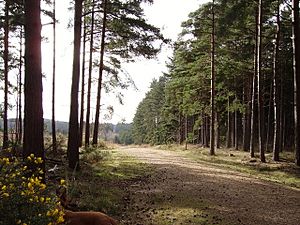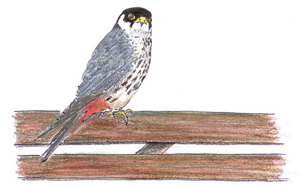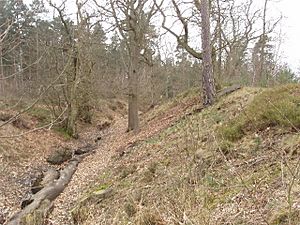Broadmoor to Bagshot Woods and Heaths facts for kids
| Site of Special Scientific Interest | |

Track through Swinley Forest
|
|
| Area of Search | Berkshire Surrey |
|---|---|
| Interest | Biological |
| Area | 1,696.3 hectares (4,192 acres) |
| Notification | 2000 |
| Location map | Magic Map |
Broadmoor to Bagshot Woods and Heaths is a huge natural area in Berkshire and Surrey. It covers about 1,696.3-hectare (4,192-acre) of land. This makes it a Site of Special Scientific Interest (SSSI). An SSSI is a special place protected by law because of its important wildlife, plants, or geology.
This area stretches from Crowthorne in the west to Bagshot in the south-east. It also reaches towards Bracknell and Sandhurst. It is part of a larger protected area called the Thames Basin Heaths Special Protection Area.
Two nature reserves are found within this SSSI. These are Barossa nature reserve and Poors Allotment. Both are looked after by the Surrey Wildlife Trust. Another part, Broadmoor Bottom, is within Wildmoor Heath. The Berkshire, Buckinghamshire and Oxfordshire Wildlife Trust manages this section.
Contents
What Makes This Area Special?
This SSSI is like a giant natural puzzle. It has many different types of habitats. These include wide areas of broadleaved woodland (forests with trees that lose their leaves). There are also coniferous plantations (forests with cone-bearing trees like pines).
Amazing Habitats
You can find both dry and wet heathland here. Heathland is an open area with small shrubs like heather. There are also valley mires, which are wet, boggy areas. You'll also see several ponds with special, less fertile water.
These different habitats are home to many interesting creatures. They support important populations of birds like the woodlark, Eurasian nightjar, and Dartford warbler. These birds are very special and need protection. The area also has many different types of dragonfly and damselfly.
The site includes important peatland areas. These are called Broadmoor Bottom and Wishmoor Bottom. They are some of the best examples of this rare habitat in the region.
The Land Beneath Our Feet
The ground here is mostly made of sand and gravel. This means water drains away easily, so the area is often dry. However, there are small pockets of clay near the surface. These clay areas help create shallow, sheltered pools of water. These pools are important for many plants and animals.
Who Uses This Land?
Part of this special area is used by the Royal Military Academy, Sandhurst. This is a place where soldiers are trained. The SSSI also includes parts of Swinley Forest. This is a large woodland area in the Bracknell Forest district.
Birds That Call This Place Home
The mix of open heathland, wet valley bogs, and woodlands is perfect for many birds. You can find heathland birds like the stonechat and common redstart.
Three very special and vulnerable bird species live here. These are the woodlark, nightjar, and Dartford warbler. The site also has a small group of hobbies that breed here. The hobby is a type of small falcon.
Protecting Our Feathered Friends
Forestry workers manage the coniferous woodlands. They sometimes clear areas and then replant new trees. This creates temporary open spaces. These new areas, along with places damaged by storms, become perfect breeding spots. The woodlark, hobby, and nightjar use these developing heathland areas. For example, some Sitka spruce plantations have been cut down near Caesar's Camp. This has helped these special birds expand their homes.
Discovering Ancient History
This area is not just important for nature. It also has some amazing historical sites.
Caesar's Camp: An Iron Age Mystery
One very interesting feature is an Iron Age hill fort called Caesar's Camp. It's one of the biggest hill forts in southern England. A hill fort is an ancient settlement built on a hill for defense.
Some of the trees have been cleared from the site. This makes it easier to see the huge earthworks of its walls. A few Iron Age coins have been found here. However, archaeologists have not fully dug up the site yet.
Roman Roads and Old Training Grounds
An important Roman road, called the Devil's Highway (Roman Britain), also crosses these woods and heathland. It runs from east to west. This road led to the Roman town of Calleva Atrebatum.
The Roman road is connected to the Iron Age fort by a shorter path. This path goes through a small Roman settlement called Wickham Bushes. Bits of pottery, tiles, and nails have been found here. This suggests it might have been a stopping point on the Roman road. But like Caesar's Camp, it hasn't been fully explored by scientists.
You can also find many redoubts in the area. These are small forts or earthworks. Soldiers built them to practice their engineering skills during the Napoleonic Wars.



